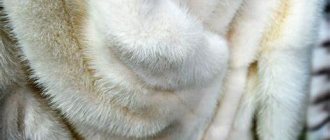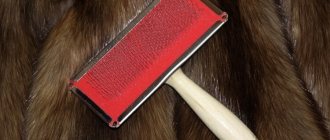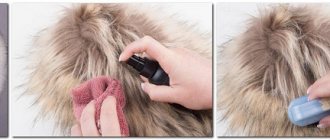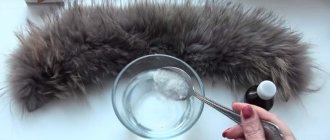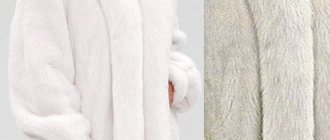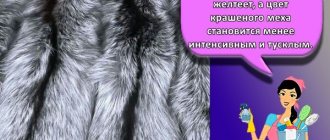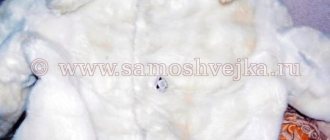A fur coat, like any other thing, needs care and regular cleaning. Wherein Caring for a fur coat made from natural fur should be comprehensive.
Dry cleaning helps to get rid of visible dirt, but no one can guarantee that after this procedure the fur coat will not lose its appearance. In some cases, after treating a fur coat with chemicals, its fur begins to crumble, and the inner layer itself becomes dry and brittle.
To avoid letting your fur coat reach this state, you need to periodically clean it at home. There are many folk remedies for this and more.
Is it possible to wash fur?
Of course, natural fur cannot be washed; it can peel off and deteriorate. The least predictable result is that the product will lose its shape under the influence of water. But over the years, numerous other methods of cleaning fur from contaminants have been tested.
IMPORTANT!
Manipulations to remove dirt from fur products should be carried out extremely delicately and thoughtfully.
If you approach the issue patiently and carefully, the result will definitely please you, and you will extend the life of the product. To maintain the overall neat appearance of fur outerwear, areas that are especially susceptible to contamination should be regularly cleaned: sleeves and collars.
To begin with, the item should be thoroughly dried and carefully but thoroughly combed. Many particles of dust and dirt that spoil the overall appearance are removed from a dry fur coat with a strong air flow (we use a hair dryer, or, conversely, a vacuum cleaner).
IMPORTANT!
We do not use a hot jet or strong mode! Then the pile will not be damaged and will return to its original place after the end of the air exposure.
How to clean white fur
A product made of white or cream fur looks royal, but such clothes get dirty very quickly. How to clean light fur? Use affordable and effective options.
Semolina, starch, talc
A universal way to get rid of greasy marks and stains of grease and sweat is to cleanse with starch, talc or semolina. Such cleaning will return the product to its former shine and eliminate the unpleasant odor.
What do we have to do? Use the step-by-step guide:
- Heat semolina, talcum powder or starch in a clean frying pan or microwave.
- Lay the fur item on a table or ironing board. Sprinkle the powder onto the contaminated area.
- Remember the fur with your hands.
- Brush off any remaining grains that have absorbed dirt and grease.
It is important not to leave any residue on your fur coat, as it will attract moths. If the brush does not help, use a vacuum cleaner.
Acetone and soda
Acetone helps remove greasy marks:
- Mix acetone (or alcohol) with baking soda to make a thick paste.
- Apply the mixture to the stain.
- Wait 20 minutes and remove any residue with a dry cloth. Then comb the fur with a brush.
Lemon juice
Has your fur item lost its shine? Use this recipe:
- Squeeze the juice from one lemon. Dilute it with water (1:1).
- Soak a piece of fabric in the solution and squeeze thoroughly.
- Process the fur lint by lint.
Make sure the fur is not wet. Lemon liquid should be used to wipe the product, not wet it.
Fur items require proper storage and care conditions
Basic rules here:
- Fur coats should be hung flat on hangers
- In the warm season, it would be good to put hats on blanks (for example, a cardboard cylinder of a suitable diameter, close to the size of the head) so that they do not become deformed, there are no creases, etc. It is better to store hats in ventilated boxes, like hats, but not in plastic bags
- Never dry on a radiator or store near heating devices.
- During storage, branches of fragrant geranium, tobacco or citrus fruit peels will help protect fur from moths.
- It is ideal to store or transport fur products in special “breathable” covers. A snow-white shade of an initially white item (fur coat or hat) will help preserve the blue color of the case
- Ironing, of course, is prohibited, even the lining
- Do not use chemicals containing chlorine for cleaning
- To protect the lint on the sleeve cuffs and collar from abrasion, it is recommended to wear silk scarves around the neck and muffs on the arms.
- Do not leave fur coats and hats in the light for a long time, especially in the open sun, as light-colored items can acquire a yellow tint over time, while dark-colored items fade quickly.
Methods for cleaning fur products
To remove tangles (clumps of matted wool) and other types of mechanical contaminants at home, you can use abrasive materials available to everyone: semolina, bran, talc or starch.
They are able to level and polish the texture of the product, do not stick and are easily removed. One of the listed products is poured into a frying pan for slight heating. Then they rub it into the pile (again, without fanaticism), shake it off or clean it off the surface with a soft brush.
Another effective method from this series is the use of sawdust (you can buy, for example, in the pet department). The sawdust is first moistened and soaked in a small portion of alcohol. Then they apply it to the contaminated surface, give it time to absorb the dirt, and shake it off. The only caveat is to make sure, at least by smell, that the sawdust is not from coniferous trees containing resin. Otherwise, there will be a risk of not cleaning the product with them, but rather getting dirty.
For removing stains of grease, paint, etc. they use gentle chemicals, which, in addition to cleansing, are designed to help restore the silkiness of the fur to the touch, increase the strength, flexibility and elasticity of the skin under the pile. Let's take a closer look at these methods.
Method 1.
Let's say there is a need to soften and restore the former elasticity of the skin under the fur. To begin with, lightly trim the seams at the lining of the product so that there is access to the interior.
The flesh is slightly moistened with a “cocktail” of 1 tablespoon of water, 1 tablespoon of vinegar essence and ½ spoon of salt. The wet material is pulled very carefully in all directions. Vinegar will also help in cases where the pile has lost its shape and shine. It is necessary to wipe the surface of the fur, without exposing its base, with a cloth moistened with the solution.
Method 2.
If the flesh has hardened as a result of thoughtless drying using heating devices, you can wipe it with alcohol or vodka diluted with water.
Method 3.
To soften, for example, a leather item upholstered with fur, glycerin water is well suited. Its use will prevent the base of the collar from hardening, and will give the collar pile a silky appearance and feel.
Method 4.
Dissolve a small amount of shampoo for washing pets in warm water, moisten a regular sponge in this solution and clean the fur without much effort. After this procedure, simply blot the wool with a cotton cloth or dry napkin. This is a particularly effective method for products made from arctic fox, fox, and silver fox.
Method 5.
A mixture of water and gasoline taken in equal proportions effectively removes grease stains. Contaminated areas are also wiped with a sponge soaked in the solution, and then with wet wipes.
Method 6.
You can try to clean problem areas (stains from grease, sweat) with the following composition: water, ammonia, transparent dishwashing gel. Everything is taken in equal parts. After cleaning with a sponge soaked in this solution, the pile is again blotted with a napkin.
Method 7.
Or this solution for the previous problem. Mix ammonia (1 teaspoon) with salt (3 teaspoons) and water (5 teaspoons). Using a sponge soaked in the mixture, treat the stain from grease or sweat.
Method 8.
A mixture made from starch and gasoline will help remove yellowness on light-colored items, as well as stains from foundation on the fold of the collar. The ingredients are mixed until creamy, scooped onto a sponge or brush and treated the contaminated area.
Then they dry it. This cleaning method is effective even on old dirt or hardened stains. Gasoline scrubs, and starch absorbs dirt. After this procedure, shake the product well, and the stain will be removed along with the starch. And the smell of gasoline will disappear after drying in the open air.
IMPORTANT!
To eliminate the smell of gasoline, you should not spray perfume on a light-colored item. Yellow spots will remain!
Method 9.
How to clean mink fur at home? A mixture of water, alcohol (including ethyl) and vinegar mixed in equal proportions will help to scrub products made from mink fur, as well as rabbit, goat, and wolf fur. After cleaning, wash off the fur coat or boots decorated with fur parts with a sponge soaked in warm water.
Method 10.
Items made from the skins of waterfowl (muskrat, beaver) can be easily cleaned with dry river sand. It must be sprinkled on the product and removed with a brush along with any dirt.
Method 11.
Following the previous example, rabbit fur is effectively cleaned with wheat bran.
Method 12.
In most cases, the scribble will return to its original appearance after strong shaking. It is more rational to store astrakhan products in the future by stuffing them with paper or fabric material in order to prevent loss of shape. To clean astrakhan fur, river sand, rye flour, bran or semolina are used. But after using them, they require more thorough shaking than in the case of other straightened bellows.
Method 13.
Oil paint stains can be easily removed with sunflower oil. Using a piece of cloth or a sponge soaked in oil, carefully wipe the stained area against the growth of the lint. Rinse off with a damp cloth.
Method 14.
Acetone or white spirit will help remove marks from a ballpoint pen. Add a drop of lemon juice to warm water to rinse off to eliminate the unpleasant odor.
Method 15.
Rubbing alcohol will remove traces of lipstick or other makeup. Clean with a soaked cotton pad.
Method 16.
The fur has turned yellow, how can I clean it?
A mixture of a spoonful of salt and 1/2 spoonful of ammonia dissolved in water will help to remove yellowness from even white items. Hydrogen peroxide gives the same whitening effect.
A damp cotton pad is moistened with the chosen product and the fur is wiped. Bran is also effective against yellowness; it is slightly heated in a frying pan, applied to the product and shaken off after a while.
IMPORTANT!
Comb the fur only in the direction of hair growth, otherwise it may break out.
After cleaning an item made of natural fur using one of the methods listed above, shake the item thoroughly, straighten and smooth the pile with your hand, and wear the updated item of clothing carefully and with pleasure.
How to clean faux fur at home?
This material is not as vulnerable and demanding to care for as natural fur, and yet care in relation to it is not canceled. If stains appear, it is more rational to clean the product immediately, without delaying it, since otherwise the material may become deformed.
IMPORTANT!
Acetone and vinegar should not be used to clean faux fur from dirt.
Cleaning with improvised means
If professional fur cleaning products are not available, then at home you can use old, time-tested, simple substances that will help clean the fur item from grease and dirt. Hot sand treatment is most often recommended. This type of processing is suitable for fur coats made from mole, beaver, and otter skins.
Hot sand is suitable for processing fur coats made from mole, beaver, and otter skins
To work, you will need clean, washed dry sand, heated on a baking sheet to a temperature of 40 degrees.
To carry out the procedure:
- the product should be laid out on a level place;
- contaminated areas are sprinkled with sand and rubbed clockwise with the palm of your hand;
- sand is removed as it becomes dirty and clean sand is added.
The product will be considered cleaned when the palm stops getting dirty.
Sand can be replaced for light fur with wet starch or talcum powder. They absorb grease and dirt well, but are very difficult to comb out. For dark mink fur, it is better to use semi-dry tea leaves.
Talc absorbs grease and dirt well, but is very difficult to comb out
You can use sawdust from deciduous trees if the item is too dirty. They are lightly moistened with pure gasoline, and after thorough cleaning they are taken outside to remove odors. This is how sheepskin is often cleaned.
Semolina can be used as a cleaning agent for white fur.
As a means for cleaning white fur, you can use bran, semolina or wheat. They need to be calcined, cooled to body temperature and applied to contaminated areas in the same way as sand.
You can use sawdust from deciduous trees if the item is too dirty.
If you need to restore the whiteness of a white fur coat, you can treat the pile with hydrogen peroxide after cleaning and drying. Peroxide will not harm the guard hair or fluff; it discolors the yellowness.
Peroxide will not harm the guard hair or fluff; it discolors the yellowness
Wash
If the fur is very dirty or the fabric of the product itself is dirty, simple cleaning will not help. In such cases, you should wash the item by hand. This is only possible if the pile is placed on a synthetic or mixed base. Before washing, you should carefully review the instructions on the label:
- Rub laundry soap into warm water or add shampoo, stir until soap foam forms. To achieve a better effect, you can replace these products with household chemicals for fur products.
- Dip the item that needs to be washed into the resulting solution, gently squeeze it in your hands, but do not rub it - this will ruin the lint.
- The next stage of washing is rinsing in cool water, which needs to be changed as often as possible.
- At the end, add a little antistatic agent to clean water and rinse the product again.
- Wrap the clothes in a terry towel and gently blot the fur with it. Do not rub artificial bristles under any circumstances.
- Hang the item over the bathtub or basin so that it is completely straightened: you can take a hanger. After most of the moisture has drained, you should take the clothes out into the fresh air.
- When the product is completely dry, comb it. If the fur serves as a lining, it should be ironed at a low temperature. However, before you do this, check the information on the label.
To wash faux fur, you can use a washing machine if there is no sign in the instructions prohibiting this procedure. Here's what you need to do:
- Load a fur coat or any other fur product into the machine by selecting “Pre-soaking”.
- Afterwards, you need to set the “Delicate Wash” mode; if this is not the case, use another one with similar settings. The time should be set to a minimum - preferably no more than 30 minutes.
- Using “Gentle Spin”, complete the wash. In the absence of such a function, it is better not to wring out the item in the machine at all, but to gently blot it with a towel.
Attention! If there is a “Do Not Wash” sign on the label, you should not try to wash the faux fur item yourself; you should immediately take it to the dry cleaner.
